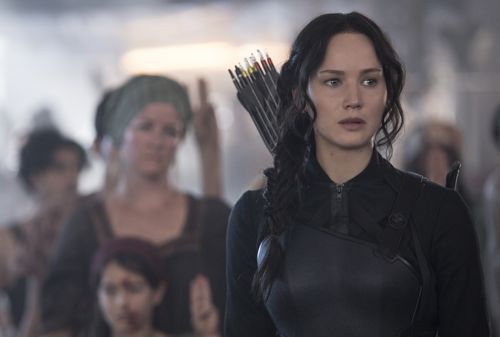
The problem with splitting Mockingjay, the third novel in the Hunger Games series, into two separate movies has nothing to do with an insufficient amount of plot. Plenty of stuff happens in the movie—and, presumably, the book, which I haven’t read. The problem—although it’s not quite a ruinous one—is that of tone. I assume—again, just guessing here—that the book The Hunger Games: Mockingjay ends on a note of optimism, or at least one of action. But the first installment of the film is characterized by inaction, by the lead character’s ennui.
Look, we can’t blame Katniss (Jennifer Lawrence) for being a little bummed out. She thinks Peeta is dead, and once she discovers he’s alive, she finds him to be a shadow of himself, acting as a puppet for President Snow (a deliciously evil Donald Sutherland). Her village has been decimated. The Capitol is gaining more and more power. She basically has PTSD.
She’s a different Katniss from the one we’ve grown to know and love—who was never what you would call spunky, but was always willing to step up to the plate and bravely be the hero for the ones she loves.
“This is not the girl you described,” says Alma Coin (Julianne Moore), the leader of the rebellion, coolly observing Katniss from behind her long white bangs. But Plutarch Heavensbee (a wily Philip Seymour Hoffman, to whom the film is dedicated) assures her that Katniss will snap out of it. After all, they have no choice. The Hunger Games has always been about propaganda, how symbols are the most important tools in stirring an oppressed people. Without Katniss serving as the “Mockingjay,” the symbolic leader of the rebellion, there is no rebellion.
Slowly, Katniss emerges from her malaise, but just barely. She’s newly enraged when she sees the destruction of her village, first hand. She’s enraged—and energized—again, when the Capitol bombs a hospital. (That’s when the camera crews, led by Natalie Dormer’s badass Cressida, jump in to film some rousing footage of her anger.) And she shows some of her classic Katniss gumption when she sets her demands to President Coin: She’ll help the rebellion if they promise to free Peeta and the other surviving tributes. Also, if they let her sister keep her cat.
The growing mutual respect between President Coin and Katniss is one of my favorite things about Mockingjay Part 1. It’s wonderful to see these two great actresses face off against each other. Indeed, I love all the female characters in the film. On top of Katniss and President Coin, we have the fierce Cressida (note to my readers: Natalie Dormer looks great with half her head shaved—you will not) and Elizabeth Banks’ Effie Trinket, a singular creation who just gets more layered and sympathetic—but no less amusing—with each film.
The worst thing about the film, aside from the slightly too-dour tone, happens to also be the worst thing about the whole trilogy: The unspeakable lameness of the love triangle. I can’t even say for sure that it is a love triangle, as it’s so feeble, so stacked in one direction, it hardly exists. Liam Hemsworth’s Gale may be hunky and honorable and true, but he’s also a colossal bore, and Katniss can barely seem to muster any interest in him. Meanwhile, practically every other word out of her mouth is “Peeta.” (if it were a drinking game, it would send several people to the emergency room.) And even in the throes of whatever brainwashing or torture he’s been subjected to, Peeta is equally obsessed with her.
As placeholders go, though, The Hunger Games: Mockingjay, Part 1 was pretty good. It gave Jennifer Lawrence a chance to show off her considerable acting chops. And it sets up what I hope will be a thrilling—and action-packed—finale.
